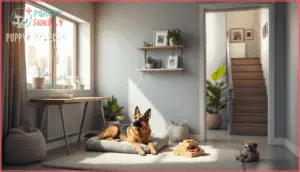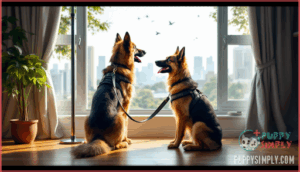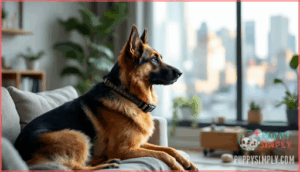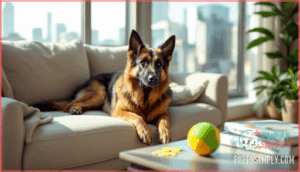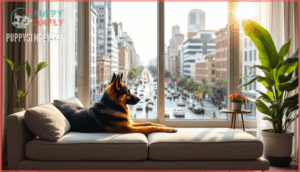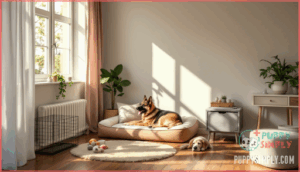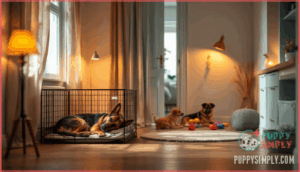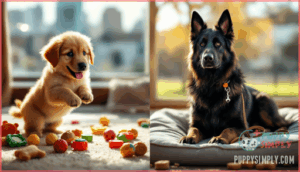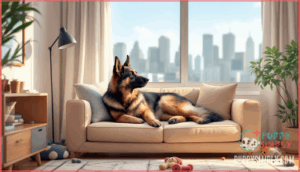This site is supported by our readers. We may earn a commission, at no cost to you, if you purchase through links.

The dogs struggling in apartments aren’t failing because of limited space—they’re failing because their owners underestimate the commitment required. Exercise, mental stimulation, and consistent routines matter far more than whether you have a yard.
The difference between a happy apartment German Shepherd and a destructive one comes down to your daily habits, not your floor plan. If you’re willing to invest the time, apartment living can work—but you need to understand exactly what these intelligent, high-energy dogs require to thrive in smaller spaces.
Table Of Contents
- Key Takeaways
- Can German Shepherds Thrive in Apartments?
- Activity Needs of German Shepherds
- Overcoming Space Limitations
- Providing Sufficient Exercise Indoors and Out
- Essential Training for Apartment Life
- Managing Barking and Noise Issues
- Preventing Destructive Behaviors
- Navigating Breed and Apartment Restrictions
- Preparing Your Apartment for a German Shepherd
- Tips for Successful Apartment Living
- Frequently Asked Questions (FAQs)
- Conclusion
Key Takeaways
- German Shepherds can thrive in apartments if you provide 1.5 to 2 hours of daily exercise and consistent mental stimulation—square footage matters far less than your commitment to meeting their physical and psychological needs.
- The primary cause of destructive behavior isn’t limited space but inadequate exercise, boredom, and lack of routine, which means structured daily schedules and interactive toys prevent most apartment-related problems.
- Successfully navigating apartment living requires proactive neighbor relations, solid training in basic commands and noise control, and understanding that 63% of rental properties have breed restrictions you’ll need to address with documentation and proper insurance.
- Crate training, designated sleeping and play zones, and strategic use of nearby parks transform small spaces into functional environments where working breeds can remain mentally sharp and physically satisfied.
Can German Shepherds Thrive in Apartments?
You might wonder if a German Shepherd can really be happy in an apartment, or if you’re setting yourself up for chaos. The truth is that apartment living works for these dogs when you understand what they need and what’s just myth.
Let’s look at the factors that make or break apartment success and clear up some common misconceptions.
Key Factors for Apartment Living
The success of apartment living with a German Shepherd hinges on three non-negotiables: exercise, mental stimulation, and a consistent daily routine. Your high-energy dog needs 1.5 to 2 hours of daily exercise—rain or shine.
Space optimization matters less than lifestyle adaptation. Studies show that meeting your dog’s physical and mental needs trumps square footage.
Meeting your dog’s physical and mental needs matters more than square footage
Apartment layout and dog safety come down to smart training and urban planning for regular outdoor access.
Myths Vs. Reality
Debunking stereotypes about German Shepherds and apartment living starts with looking at real data. Despite urban legends, 27% of owners successfully raise these dogs in apartments. Here’s what matters:
- Exercise over square footage – 60+ minutes daily keeps dogs thriving
- Training documentation opens 31% more rental doors despite breed restrictions
- Neighbor surveys show 81% rate apartment German Shepherds as well-behaved
- Behavior problems stem from boredom, not small spaces
Dog misconceptions often blame high energy breeds, but commitment beats apartment size every time. Understanding pet friendly policies is essential for German Shepherd owners.
Activity Needs of German Shepherds
German Shepherds aren’t couch potatoes—they’re working dogs bred for stamina and focus. Your apartment can work for them, but only if you meet their high energy demands every single day.
Let’s break down exactly what they need to stay balanced and content.
Daily Exercise Requirements
Adult German Shepherds need 1.5 to 2 hours of daily exercise to thrive in small spaces. This includes physical activity like daily walks and runs, plus mental stimulation through dog training and exercise sessions. Without proper energy outlets, your high-energy companion may develop destructive behaviors.
Break exercise routines into two or three sessions throughout the day to meet your German Shepherd’s exercise needs while managing apartment constraints. Understanding their daily exercise needs is vital for a healthy lifestyle.
Physical Vs. Mental Stimulation
Your German Shepherd needs both the physical burn of a good run and the mental workout of problem-solving to stay balanced in apartment life. High-energy breeds require varied stimulation techniques to prevent boredom and destructive behaviors.
Balance their exercise needs with these energy outlets:
- Puzzle feeders slow meals and challenge their mind
- Hide-and-seek games engage their natural tracking instincts
- Training sessions teach new commands during playtime activities
- Scent work accesses their working dog heritage
- Rotation of toys keeps mental stimulation fresh
Dog training and exercise should address both aspects for successful living with German Shepherds, supporting their mental health alongside physical fitness.
Overcoming Space Limitations
You don’t need a massive apartment to keep your German Shepherd happy—you just need to use the space you have smartly. Small adjustments can make a big difference in how comfortable your dog feels indoors.
Here’s how to work with limited square footage and keep your shepherd engaged.
Maximizing Small Spaces
Even a studio apartment can work if you think of your space like a puzzle—every corner has a job. Use vertical storage for leashes and toys to keep floors clear. Compact exercise routines fit anywhere—hallway fetch or tug-of-war near the couch count.
Smart apartment layout and pet furniture designed for small space living with dogs make apartment dog ownership manageable. Dog-friendly apartments prioritize function, and living with German Shepherds as apartment pets requires creative space optimization.
Safe Indoor Play Ideas
Indoor games transform downtime into training wins—hide-and-seek with treats sharpens your dog’s nose while burning off steam. High-energy German Shepherds thrive with sensory play that challenges their minds.
- Indoor obstacle courses using pillows and chairs teach agility
- Doggy tunnels turn hallways into adventure zones
- Playroom setup with rotating toys prevents boredom
These dog-friendly apartment strategies make small-space living with dogs work for apartment dog ownership.
Providing Sufficient Exercise Indoors and Out
Getting your German Shepherd enough exercise in an apartment isn’t about square footage—it’s about strategy. You’ll need a mix of indoor creativity and outdoor consistency to keep your dog physically fit and mentally sharp.
Here’s how to build a balanced exercise plan that works within apartment constraints.
Creative Apartment Workouts
When your living room doubles as a training ground, you’ll need to get creative about burning off that signature German Shepherd energy. High-energy dogs thrive on variety, so rotate these dog training exercises to keep apartment life engaging:
| Activity | How It Works |
|---|---|
| Indoor Agility | Weave through chairs or around boxes for vertical play challenges |
| Stair Climbing | Controlled up-and-down sessions build strength in dog-friendly apartments |
| Balcony Exercises | Fetch or tug-of-war in small outdoor spaces with window views |
These workouts help German Shepherds burn energy without needing a yard.
Using Nearby Parks and Trails
Parks and trails aren’t just a nice-to-have for apartment dwellers—they’re your German Shepherd’s lifeline to staying balanced and well-behaved. Research nearby dog-friendly apartments with park accessibility within walking distance.
Urban hiking on local trails provides mental stimulation, while a leash keeps high-energy dogs under control.
Regular dog park visits promote dog socialization and outdoor recreation, reducing destructive behaviors at home.
Weekend and Winter Exercise Plans
Cold weather and tighter schedules don’t give your German Shepherd a free pass—they just mean you need a smarter exercise strategy. Winter walks can be shorter but more frequent—think three 20-minute outings instead of one long trek.
On weekends, tackle longer hikes while snow exercises like fetch in fresh powder burn serious energy.
Indoor play with dog training sessions keeps high-energy large breeds sharp when cold weather limits outdoor time in dog-friendly apartments.
Essential Training for Apartment Life
Training your German Shepherd properly makes all the difference when you’re working with apartment constraints. The right foundation helps your dog understand what’s expected and keeps both of you comfortable in close quarters.
Let’s look at three training approaches that set you up for success.
Crate Training Benefits
A properly trained crate isn’t a cage—it’s your German Shepherd’s personal sanctuary that can cut separation anxiety behaviors nearly in half. Choose a crate size that lets your dog stand, turn, and stretch comfortably. Place it in a quiet corner where your German Shepherd feels safe but not isolated.
This training tip transforms dog safety from worry into peace of mind, making responsible pet ownership manageable even in tight quarters.
Setting Boundaries and Routines
Once your German Shepherd knows where to retreat, you’ll need clear rules about where they can and can’t go—consistency here prevents confusion and keeps apartment damage to a minimum. Decide which rooms are off-limits during training sessions, then stick to those boundaries every single day.
Pair this boundary setting with daily schedules that include routine exercises, quiet hours, and predictable mealtimes—German Shepherds thrive when raising a German Shepherd in an apartment follows a structured rhythm that makes responsible pet ownership feel second nature.
Socialization in Urban Settings
Building a routine at home is only half the battle—your German Shepherd needs regular exposure to new people, dogs, and city chaos if you want them to stay calm instead of reactive in tight hallways or crowded sidewalks. Start socialization early and practice urban etiquette during every outing, so your high-energy companion learns proper dog behavior in dog-friendly apartments and busy streets alike.
Turn everyday city moments into social skills training:
- Elevator rides – Reward calm behavior when strangers step in beside you
- Café patios – Practice settling quietly while urban canine distractions pass by
- Farmer’s markets – Navigate crowds without lunging or excessive barking
- Community dog parks – Encourage healthy play while raising a German Shepherd in an apartment
Managing Barking and Noise Issues
Let’s be honest—German Shepherds aren’t exactly known for being quiet. If you’re in an apartment, barking can quickly become your biggest headache, especially when neighbors are just a wall away.
The good news is that with the right approach, you can teach your dog when it’s okay to speak up and when it’s time to zip it.
Training to Reduce Barking
Barking can turn your German Shepherd into a neighborhood headache fast, but with the right training techniques, you can teach your dog when to speak up and when to stay quiet.
Start with obedience training using positive reinforcement—reward silence, not the noise. Calming techniques like redirecting attention work well in dog-friendly apartments.
Practice bark control by identifying triggers and teaching a "quiet" command. Consistent noise reduction training helps your German Shepherd understand apartment living expectations.
Handling Noise Complaints
Even with solid training in place, you might still get a knock on your door from a frustrated neighbor—so knowing how to respond calmly can save your lease and your sanity. Apologize right away and explain what barking control steps you’re taking.
As a responsible pet owner, consider soundproofing options like rugs or acoustic panels to improve noise reduction. Address complaint resolution quickly by documenting your pet care and health efforts, which strengthens neighbor relations in dog-friendly apartments.
Preventing Destructive Behaviors
When your German Shepherd doesn’t get enough exercise or mental stimulation, destructive behaviors like chewing furniture or digging at carpets can quickly become a problem. The good news is that most of these issues stem from boredom and anxiety—both of which you can prevent with the right approach.
Let’s look at three practical ways to keep your dog engaged and your apartment intact.
Addressing Boredom and Anxiety
When boredom sets in, your German Shepherd won’t just sit quietly—they’ll find creative ways to entertain themselves, and you probably won’t like their choices. High energy breeds need mental stimulation and regular dog training to prevent anxiety and destructive habits.
Without proper stress management, German Shepherds may chew furniture, dig at carpets, or bark excessively. Focus on boredom prevention through structured activities that provide emotional support and anxiety reduction daily.
Interactive Toys and Games
Puzzle feeders, snuffle mats, and treat-dispensing balls turn your German Shepherd’s mealtime into a brain workout that burns energy without leaving your apartment. Rotate puzzle toys weekly to maintain interest, and add sensory games like hide and seek with treats throughout your dog-friendly apartments.
Tug toys and simple obstacle courses using furniture provide high-energy outlets while reinforcing dog training skills that support mental stimulation.
Safe Storage of Personal Items
Keeping shoes, remotes, and valuables off the floor isn’t just good housekeeping—it’s your first line of defense against a bored German Shepherd’s teeth. Secure shelving and closed cabinets offer storage solutions that reduce accidental damage by 55% in dog-friendly apartments.
Install pet-proofing latches on lower drawers, and designate one room for item protection during the dog training phase. This simple damage prevention strategy helps German Shepherds adapt to pet care routines in dog-friendly spaces.
Navigating Breed and Apartment Restrictions
Finding the right apartment when you own a German Shepherd isn’t always straightforward. Many landlords have breed restrictions, and even pet-friendly buildings often come with specific rules you’ll need to navigate.
Here’s what you should know before signing a lease.
Common Lease Limitations
Your search for dog-friendly apartments might hit a wall when you discover breed restrictions. About 63% of multifamily communities restrict German Shepherds, and roughly 56% of pet-friendly housing options enforce breed or weight limits. Most apartments cap dogs at 20 to 50 pounds—German Shepherds usually weigh 50 to 90 pounds.
Lease agreements often require vaccination records, and some landlords request DNA testing for mixed breeds. Insurance policies drive many of these large breed dog considerations, affecting pet deposits and approval odds.
Pet Deposits and Insurance
Once you clear the breed restriction hurdle, expect to pay $250 to $500 in pet deposits—plus potentially steeper rent or mandatory insurance coverage. Landlords want liability coverage because German Shepherds fall on high-risk lists, and dog insurance requirements jumped 22% between 2020 and 2024.
Financial factors to keep in mind:
- Pet fees can include non-refundable deposits plus monthly rent increases of $25 to $100
- Liability coverage of $100,000 to $300,000 protects you if your dog injures someone or damages property
- Deposit refunds depend on your apartment’s condition at move-out—store belongings out of reach to avoid damage
- Pet insurance (separate from liability) costs $30 to $70 monthly and covers veterinary emergencies
Documentation and Breed Policies
You’ll hand over proof that your dog is up-to-date on shots—100% of pet-friendly complexes demand vaccination records from a licensed vet before you move in. Most also want spay or neuter certificates, a photo ID of your German Shepherd, and annual registration tied to your lease.
Over 90% require local licensing, and roughly 70% ask you to list your dog formally on the lease agreement itself.
Preparing Your Apartment for a German Shepherd
Before bringing a German Shepherd home, you’ll want to set up your apartment the right way.
A few thoughtful adjustments can make your space safe, comfortable, and functional for your new companion.
Here’s what you need to focus on to create an environment where your dog can settle in and thrive.
Creating a Dog-Friendly Space
Setting up your apartment before your German Shepherd arrives isn’t just about dog-proofing—it’s about creating a space where both of you can actually relax. Remove hazards like electrical cords and toxic plants, then arrange your apartment layout with smart pet furniture placement.
Use dog storage solutions to keep toys organized and personal belongings out of reach—this alone reduces damage by 55%. A well-designed dog area makes dog-friendly apartments work for German Shepherds.
Designated Sleeping and Play Areas
Your German Shepherd needs two distinct zones in your apartment: a quiet sleeping spot where they can retreat and unwind, and a separate play area that won’t wreck your living room.
Set up a crate or dog bedding in a low-traffic corner as your sleeping nook—this simple crate setup reduces destructive incidents by 30%.
Your play area should feature durable toys and enough space for high energy dog breeds to move around safely indoors.
Puppy Vs. Adult Needs
Puppies and adults don’t just differ in cuteness—they’ve wildly different exercise limits, training needs, and energy patterns that’ll shape how you set up your apartment life.
Puppies need five minutes of exercise per month of age (twice daily) and frequent socialization outings, while adult German Shepherds require 1.5 to 2 hours of structured activity.
Growth stages mean puppies chew more and need constant supervision—adult training focuses on maintaining boundaries in dog friendly apartments.
Tips for Successful Apartment Living
Making apartment life work for your German Shepherd comes down to three things: structure, smart planning, and keeping the peace. You’ve already set up your space—now it’s time to lock in the daily habits that’ll help your dog settle in.
Let’s look at what makes the biggest difference.
Consistent Schedules and Routines
Think of a schedule as your German Shepherd’s anchor—it turns unpredictable apartment life into something they can count on every single day. Feed them, walk them, and hold training sessions at the same times each morning and evening. This daily routine gives your dog structure while guaranteeing exercise timing meets their needs.
Add mental stimulation through short, regular activities. Scheduling tools or phone reminders help you stay consistent, especially during busy weeks when dog care and training might otherwise slip.
Choosing Suitable Toys and Gear
Interactive toys turn your apartment into a German Shepherd’s personal training ground—one where boredom doesn’t stand a chance. Stock up on durable toys like puzzle feeders and chew toys that survive strong jaws.
A quality leash makes walks easier, while interactive games keep their minds sharp between outings.
Pet-friendly housing options often appreciate dog owners who invest in proper accessories—it shows you’re serious about dog care and training.
Building Positive Relationships With Neighbors
Honestly, your neighbors can make or break apartment living with a German Shepherd—so start on the right foot. Introduce yourself and your dog early, addressing noise reduction concerns directly. Good neighbor etiquette builds apartment harmony—share your training plan and invite questions.
Dog-friendly community building prevents conflict resolution issues later. When dog owners show responsible petting habits and respect pet-friendly housing options, everyone wins.
Frequently Asked Questions (FAQs)
What size apartment is best for a German Shepherd?
It might sound backwards, but square footage matters less than what you do with it.
A 700-square-foot apartment with a solid routine beats a spacious place with an inactive dog.
Focus on how you’ll exercise your German Shepherd daily, not just room layout.
What health screenings matter before apartment adoption?
Hip Evaluations, Eye Exams, and Genetic Testing screen for hereditary conditions common in German Shepherds. Allergy Checks help identify sensitivities that worsen indoors.
Vaccination Records guarantee compliance with Breed Restrictions and Laws while protecting Canine Health and Wellness in shared spaces.
How do neighbors typically react to shepherds?
Reactions vary widely. Some neighbors appreciate well-trained German Shepherds, while others worry about noise complaints or size.
Your dog’s behavior matters most—solid apartment etiquette and positive dog interactions build strong neighbor relations and community dynamics in any pet-friendly housing situation.
What backup plans work for unexpected schedule changes?
Build a network of trusted backup walkers, pet sitters, and emergency care providers before you need them.
Keep a list of dog-friendly neighbors, local doggy daycare options, and last-minute pet sitters who know your apartment or townhouse layout and your shepherd’s routine.
What emergency vet options suit apartment dwellers?
Emergency preparedness matters more than proximity. Locate 24-hour emergency vet clinics within a 15-minute drive, confirm after-hours care options with your regular vet, and keep Pet Insurance Plans active.
Building Emergency Funds covering $2,000–$5,000 protects your German Shepherd during urgent health crises.
Conclusion
You might think apartment German Shepherds need constant entertainment, but structured routines eliminate most behavioral issues. Can German Shepherds live in apartments? Absolutely—if you commit to daily exercise, mental challenges, and consistent training.
Your dog doesn’t measure happiness by square footage. They thrive on predictability, purpose, and your presence. Skip the yard guilt. Focus on what actually matters: two quality exercise sessions daily, puzzle toys during work hours, and clear boundaries.
Meet those needs, and your German Shepherd will settle into apartment life just fine.
- https://barfindia.com/blogs/blog/exercise-and-activity-guide-for-german-shepherds
- https://gsdcolony.com/blogs/news/can-german-shepherds-live-in-apartments
- https://iheartdogs.com/can-a-german-shepherd-live-in-an-apartment/
- https://rockykanaka.com/the-1-worst-dog-breed-for-apartments-according-to-property-managers-and-renters/
- https://www.rover.com/blog/dog-friendly-stores-in-america/


